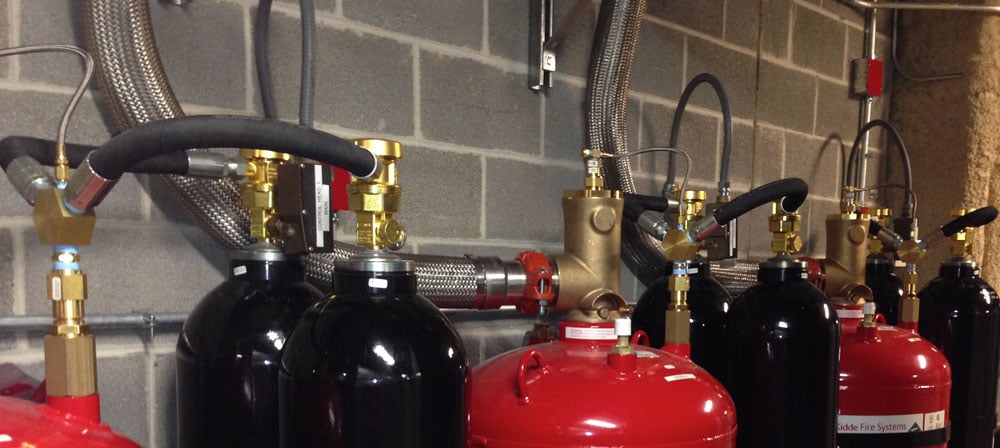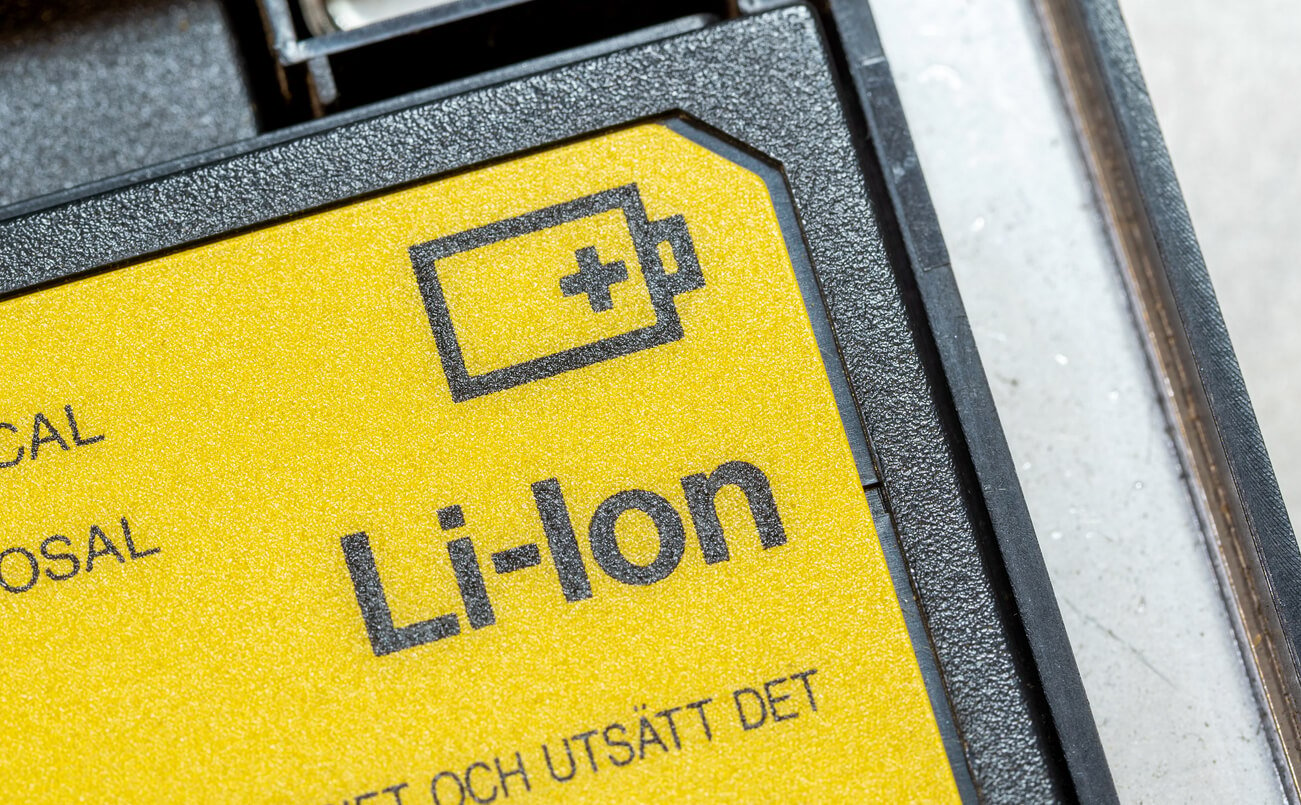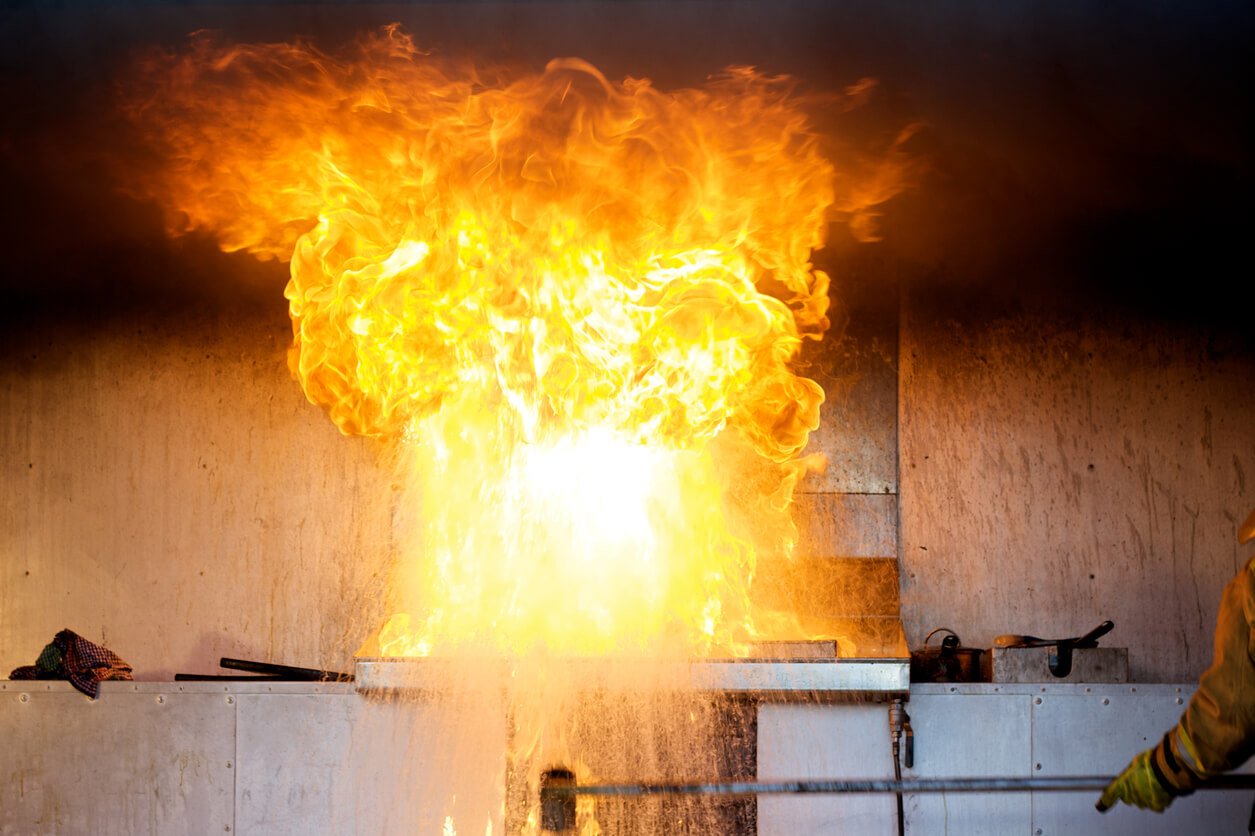What types of fire suppression systems are safe for people?
- Traditional fire sprinkler systems
- Water-mist suppression systems
- Clean agent fire suppression systems
You know that fire suppression systems are vital to preventing the spread of fire and protecting valuable business assets. But you may be wondering—if the fire suppression system goes off while a person is in the room, will the person be harmed?
The answer depends on what type of water-based or special hazard fire suppression system you have.
Before discussing a few of the most common fire suppression systems that are safe for building occupants, let’s review one type that isn’t: CO2 fire suppression systems.
Safety Considerations for Carbon Dioxide Fire Suppression Systems
Inexpensive compared to other clean agents, carbon dioxide (CO2) suppression systems use carbon dioxide, a colorless, odorless, electrically non-conductive gas. CO2 suppression systems effectively suppress various fire types, including Class A, B, and C. CO2 suppression systems are commonly used for total flooding and several industrial fire suppression applications since there is little to no clean-up and no agent residue to damage sensitive equipment.
One potential drawback is that carbon dioxide extinguishes by displacing oxygen. In some situations, that can be hazardous or even fatal to personnel. For example, the average CO2 fire suppression system requires 34% CO2 levels to sufficiently extinguish a fire, well above the acceptable exposure threshold for building occupants. CO2 causes asphyxiation in humans at 7.5% concentration and unconsciousness, convulsions, coma, and death at concentrations greater than 17%.
Therefore, CO2 isn’t a suitable suppression agent for total flooding in occupied areas and should only be used in areas that are typically unoccupied and generally inaccessible to employees and customers. Today carbon dioxide is primarily used in industrial fire protection, where the safety risks are manageable and less pronounced. However, when used, it is subject to several safety considerations, such as NFPA 12.
What Types of Fire Suppression Systems are Safe for Building Occupants?
Whether it's water-based or a special hazard fire suppression system, high-traffic facilities need a way to detect and suppress fires without endangering facility occupants. Here are a few common fire suppression systems that are safe for employees and customers.
1. Traditional Fire Sprinkler Systems
A traditional fire sprinkler system is the minimum requirement for fire suppression and code compliance for many buildings and businesses. Water, of course, is not inherently harmful to people.
However, water-based suppression systems are not the most effective type of suppression system for every circumstance. In some cases, water can be more dangerous in certain types of fires than other available extinguishing agents. It can also cause irreparable damage to equipment or property, requiring extensive cleanup and more significant business interruption.
2. Water-Mist Suppression Systems
In addition to conventional fire sprinkler systems, water-mist systems are also safe for building occupants and viable solutions for spaces that can’t be exposed to large amounts of water. Damage from water-mist suppression systems is considerably lower compared to ordinary water-based sprinkler systems.
Pro Tip
NFPA 750
Familiarize yourself with NFPA 750 to learn the design, installation, maintenance, and testing requirements for water-mist fire suppression systems. Learn More →
3. Clean Agent Fire Suppression Systems
There are three basic categories of clean agent fire suppression systems:
- Inert gas systems
- Chemical clean agent systems
- Carbon dioxide systems
While CO2 suppression systems pose significant health risks, inert and chemical clean agent systems are safe for humans and the environment. The clean agents they utilize have been approved by the U.S. Environmental Protection Agency for use in normally occupied spaces.
Let’s dive deeper into inert and chemical clean agent fire suppression systems and review a few examples of typical applications.
Inert Gas Fire Suppression Systems
These types of special hazard fire suppression systems use inert gases such as Inergen, Argonite, and Nitrogen to quickly and safely extinguish incipient stage fires. Inert gasses put out fires by smothering them and reducing oxygen levels while still leaving enough for building occupants. When designed within appropriate criteria, these systems are people-safe and approved for normally-occupied rooms.
Inert gasses are ideal for environments that house sensitive equipment such as server rooms or industrial facilities with CNC machines. As a gas, they can also migrate into air-permeable enclosures to provide extinguishment where water may not be able to reach.
One of the best special hazard fire suppression systems for applications where people are present is INERGEN. INERGEN fire suppression systems use naturally occurring gases such as nitrogen, argon, and carbon dioxide to lower oxygen content and disrupt the combustion process. This fire suppression system is the only inert gas fire suppression agent that provides a safe environment for building occupants.
Chemical Clean Agent Suppression Systems
Chemical clean agent systems use liquid compounds made of synthetic chemicals. The liquid compound is stored in cylinders and then discharged as a gas at predetermined concentrations through a fixed piping system. They extinguish fires primarily through heat absorption and leave no residue. That means they don't cause additional equipment damage, limiting facility downtime.
They are also safe for building occupants, require no special ventilation, and are approved for normally-occupied rooms when properly designed. Unlike inert gas systems, these systems generally are less hardware intensive, resulting in less of an equipment footprint and, in most cases, a somewhat lower initial installation expense.
Here is a brief overview of two common types of chemical clean agent systems: Novec 1230 Fire Protection Fluid and FM-200.
Novec 1230 Fire Protection Fluid - This chemical clean agent suppression system uses a colorless, non-toxic fluorinated ketone containing carbon, fluorine, and oxygen. Novec 1230 fluid is a sustainable clean agent, providing a replacement for halon and hydrofluorocarbon extinguishing agents. A more environmentally-friendly solution, Novec 1230 fluid is often used in data centers and other electronic-heavy facilities due to its ability to suppress fires by removing heat without causing disruptions and damage to sensitive electronic equipment.
FM-200 - This chemical clean agent suppression system uses a hydrofluorocarbon (HFC) compound containing hydrogen, fluorine, and carbon. The clean agent is stored in cylinders as a liquid and pressurized with nitrogen, saving up to seven times the space of a CO2 system or an inert gas system. FM-200 is suitable for applications where space is at a minimum and for frequently trafficked areas as it’s non-reactive, non-corrosive, and non-conductive.
Dig Deeper
Protect Your IT Infrastructure
Learn how these two chemical clean agent suppression systems can protect your valuable IT infrastructure. Learn More →
Choosing the Right Fire Suppression System for Your Facility
Whether you operate a data center, a power plant, or a chemical storage facility, your business demands a robust and effective fire suppression system. You need a reliable system that effectively neutralizes and extinguishes fires without damaging building contents, endangering facility occupants, or compromising business continuity.
However, choosing the ideal fire suppression system is a complex process. While having a knowledge base can differentiate a passive building owner from a savvy one, it is still never advisable to tackle this critical fire and life safety challenge alone.
Instead, businesses should partner with an experienced fire protection company to design a cost-effective fire suppression system that protects valuable equipment, ensures the safety of building occupants, and accounts for the specific special hazards present in their facility.
Editor’s Note: This post was originally published on September 8, 2017, and has been updated for accuracy and current best practices.








